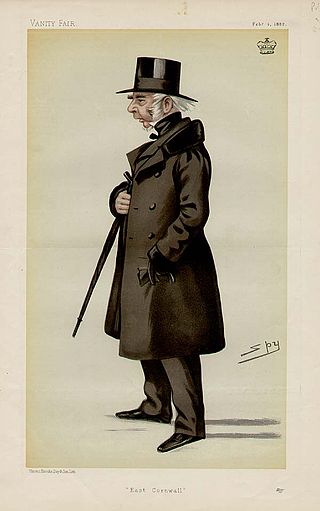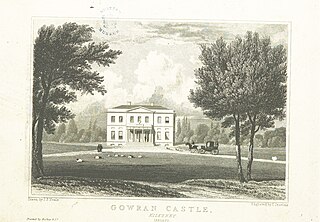
Earl of Normanton is a title in the Peerage of Ireland. It was created in 1806 for Charles Agar, 1st Viscount Somerton, Archbishop of Dublin. He had already been created Baron Somerton, of Somerton in the County of Kilkenny, in 1795 and Viscount Somerton, of Somerton in the County of Kilkenny, in 1800, also in the Peerage of Ireland. Lord Normanton sat in the House of Lords from 1800 to 1809 as one of the 28 original Irish Representative Peers.

Lanhydrock House, commonly known simply as Lanhydrock, is a country house and estate in the parish of Lanhydrock, Cornwall, UK.

Welbore Ellis, 1st Baron Mendip, PC, FRS was a British politician who sat in the House of Commons for 53 years from 1741 to 1794 when he was raised to the peerage as Baron Mendip. He held a number of political offices, including briefly serving as Secretary for the Colonies in 1782 during the American War of Independence.

George James Welbore Agar-Ellis, 1st Baron Dover PC FRS FSA was a British politician and man of letters. He was briefly First Commissioner of Woods and Forests under Lord Grey between 1830 and 1831.

Baron Dover is a title that has been created three times, once in the Peerage of England, once in the Peerage of Great Britain and once in the Peerage of the United Kingdom. All three creations are now extinct.
James Agar, 1st Viscount Clifden, was an Irish peer and politician and held the office of one of the joint Postmasters General of Ireland.

Charles Agar, 1st Earl of Normanton, was an Anglo-Irish clergyman of the Church of Ireland. He served as Dean of Kilmore, as Bishop of Cloyne, as Archbishop of Cashel, and finally as Archbishop of Dublin from 1801 until his death.
Henry Agar-Ellis, 3rd Viscount Clifden, styled the Lord Dover from 1833 to 1836, was an Irish courtier and racehorse owner.

Thomas Charles Agar-Robartes, 6th Viscount Clifden, styled The Honourable Thomas Agar-Robartes between 1869 and 1882 and known as The Lord Robartes from 1882 to 1899, was a British landowner and Liberal politician.
James Charles Herbert Welbore Ellis Agar, 3rd Earl of Normanton DL, styled Viscount Somerton from birth until 1868, was a Conservative and later Peelite member of parliament in the United Kingdom of Great Britain and Ireland before inheriting an Irish earldom and large estates in Ireland and Hampshire. In 1873 he was created a baron in the peerage of the United Kingdom, giving him a seat in the House of Lords.
Leopold George Frederick Agar-Ellis, 5th Viscount Clifden, known as Leopold Agar-Ellis until 1895, was a British Liberal politician.

Thomas James Agar-Robartes, 1st Baron Robartes, was a British politician.
Henry Welbore Agar-Ellis, 2nd Viscount Clifden SA, styled The Honourable Henry Agar between 1776 and 1789, was an Irish politician.
Arthur Victor Agar-Robartes, 8th Viscount Clifden, MC was a British Army officer and English cricketer.

Henry Agar (1707–1746) was an Irish politician, and the father of the 1st Viscount Clifden and the 1st Earl of Normanton.
Shaun James Christian Welbore Ellis Agar, 6th Earl of Normanton was an Irish and British peer, soldier, landowner, and powerboat racer. From birth until 1967 he was known by the courtesy title of Viscount Somerton. As Baron Somerton of Somerley and later as Baron Mendip he was a member of the House of Lords from 1967 until the reform of the Lords in 1999.
Edward John Sidney Christian Welbore Ellis Agar, 5th Earl of Normanton was a British and Irish peer, soldier, and landowner, a member of the House of Lords from 1933 until his death.
Sidney James Agar, 4th Earl of Normanton was a British and Irish peer and landowner, a member of the House of Lords from 1896 until his death.

Welbore Ellis Agar, 2nd Earl of Normanton was an Irish peer and landowner, of Anglo-Irish origins, who spent most of his life in England, where he acquired the Somerley estate in 1825.
Welbore Ellis Agar FRS was an Anglo-Irish gentleman, senior officer of HM Revenue and Customs, and art collector, who lived most of his life in Mayfair, Westminster.













